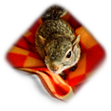Last season I had a lot of trouble finding information on Kitten Fur Syndrome when I received a squirrel to rehab with that condition. To save future rehabbers from the trouble I went through researching it, I wrote a small article and put it on a free webpage site. I hope people find it helpful:
http://www.geocities.com/insect_quee..._syndrome.html



 Reply With Quote
Reply With Quote




 +
+  =
= 
 Kensington always
Kensington always 